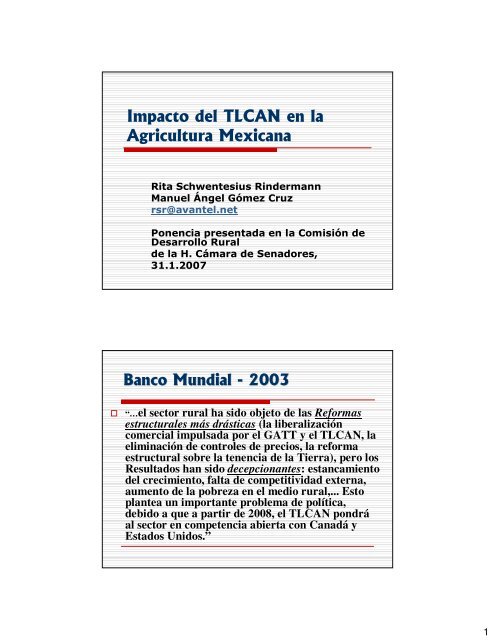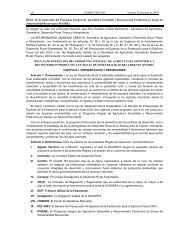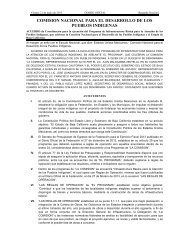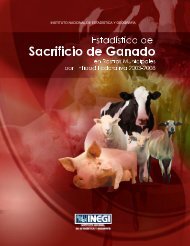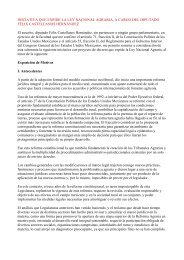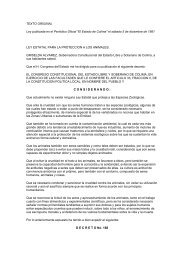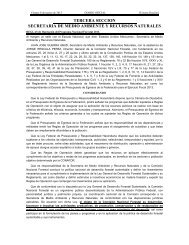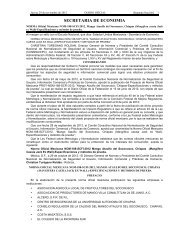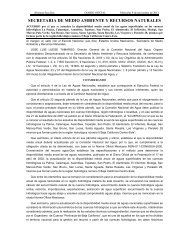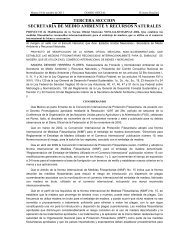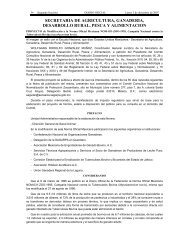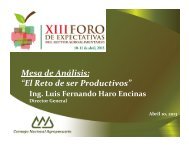Impacto del TLCAN en la Agricultura Mexicana - InfoRural.com.mx
Impacto del TLCAN en la Agricultura Mexicana - InfoRural.com.mx
Impacto del TLCAN en la Agricultura Mexicana - InfoRural.com.mx
Create successful ePaper yourself
Turn your PDF publications into a flip-book with our unique Google optimized e-Paper software.
<strong>Impacto</strong> <strong>del</strong> <strong>TLCAN</strong> <strong>en</strong> <strong>la</strong><br />
<strong>Agricultura</strong> <strong>Mexicana</strong><br />
Rita Schw<strong>en</strong>tesius Rindermann<br />
Manuel Ángel Gómez Cruz<br />
rsr@avantel.net<br />
Pon<strong>en</strong>cia pres<strong>en</strong>tada <strong>en</strong> <strong>la</strong> Comisión de<br />
Desarrollo Rural<br />
de <strong>la</strong> H. Cámara de S<strong>en</strong>adores,<br />
31.1.2007<br />
Banco Mundial - 2003<br />
<br />
“…el sector rural ha sido objeto de <strong>la</strong>s Reformas<br />
estructurales más drásticas (<strong>la</strong> liberalización<br />
<strong>com</strong>ercial impulsada por el GATT y el <strong>TLCAN</strong>, <strong>la</strong><br />
eliminación de controles de precios, <strong>la</strong> reforma<br />
estructural sobre <strong>la</strong> t<strong>en</strong><strong>en</strong>cia de <strong>la</strong> Tierra), pero los<br />
Resultados han sido decepcionantes: estancami<strong>en</strong>to<br />
<strong>del</strong> crecimi<strong>en</strong>to, falta de <strong>com</strong>petitividad externa,<br />
aum<strong>en</strong>to de <strong>la</strong> pobreza <strong>en</strong> el medio rural,... Esto<br />
p<strong>la</strong>ntea un importante problema de política,<br />
debido a que a partir de 2008, el <strong>TLCAN</strong> pondrá<br />
al sector <strong>en</strong> <strong>com</strong>pet<strong>en</strong>cia abierta con Canadá y<br />
Estados Unidos.”<br />
1
2 I d e a s para exponer<br />
¿Se cumplieron los Objetivos<br />
<strong>del</strong> <strong>TLCAN</strong> <strong>en</strong> el Sector<br />
Agropecuario?<br />
¿Es posible <strong>la</strong> R<strong>en</strong>egociación?<br />
Hipótesis<br />
El <strong>TLCAN</strong> no ha cumplido<br />
con sus Promesas.<br />
Si, es posible <strong>la</strong> Revisión<br />
y R<strong>en</strong>egociación.<br />
n.<br />
2
TLCs con 42 Países<br />
Destinos geográficos <strong>del</strong> Comercio<br />
agroalim<strong>en</strong>tario y pesquero de México M<br />
(%)<br />
Socios<br />
NAFTA<br />
U.E.<br />
Mercosur<br />
Japón<br />
Otros<br />
Exportaciones<br />
1990<br />
89,3<br />
5,4<br />
0,2<br />
2,3<br />
2,8<br />
2004<br />
86,4<br />
4,5<br />
0,2<br />
1,1<br />
7,7<br />
Importaciones<br />
1990<br />
64,6<br />
17,9<br />
5,3<br />
0,2<br />
11,9<br />
2004<br />
80,8<br />
5,7<br />
2,8<br />
0,4<br />
10,7<br />
Los TLCs no han funcionado, con <strong>la</strong> excepción n de EE.UU.<br />
Fu<strong>en</strong>te: SAGARPA, con datos de <strong>la</strong> Secretaria de Economía<br />
3
<strong>TLCAN</strong> = Peso mosca contra<br />
peso <strong>com</strong>pleto<br />
Hipótesis <strong>del</strong> CIESTAAM<br />
Negociaciones y Exclusiones<br />
So<strong>la</strong>m<strong>en</strong>te <strong>en</strong> los casos de<br />
EE.UU. y Costa Rica fueron<br />
incluidas todas <strong>la</strong>s Fracciones<br />
Arance<strong>la</strong>rias;<br />
Canadá excluyó 103<br />
Fracciones (Productos<br />
lácteos, avíco<strong>la</strong>s, margarina).<br />
El <strong>TLCAN</strong> fue mal negociado<br />
4
Objetivos <strong>del</strong> <strong>TLCAN</strong><br />
Fortalecer <strong>la</strong> Competitividad y Especializar<br />
<strong>en</strong> Productos <strong>com</strong>petitivos (Hortalizas(<br />
Hortalizas);<br />
Crear nuevas Oportunidades de<br />
Exportación n y Empleo;<br />
Ampliar Oportunidades de Crecimi<strong>en</strong>to <strong>del</strong><br />
Sector Agropecuario;<br />
Elevar el Nivel de Vida <strong>en</strong> el Medio Rural;<br />
Ofrecer Alim<strong>en</strong>tos baratos;<br />
Proteger y Preservar el Ambi<strong>en</strong>te, , etc.<br />
SARH/SECOFI, 1993 y Texto oficial.<br />
Método<br />
- Medición n de <strong>la</strong><br />
Competitividad<br />
V<strong>en</strong>taja Comercial Reve<strong>la</strong>da (VCR) =<br />
RXA i a – RMAi a , donde<br />
RXA i a = (Xi a /Xi n )/(Xr a /Xr n ) y<br />
RMA i a = (Mi a /Mi n )/(Mr a /Mr n );<br />
Competitividad Reve<strong>la</strong>da<br />
(CR) = Ln(RXA i a ) – Ln(RMAi a ).<br />
Source: Vollrath, 1989 and 1991<br />
5
Competitividad <strong>del</strong> Sector Agroalim<strong>en</strong>tario de<br />
México y EE.UU. <strong>en</strong> <strong>la</strong> región n <strong>del</strong> <strong>TLCAN</strong>, 61-2004<br />
3.35<br />
2.35<br />
México<br />
EE.UU.<br />
1.35<br />
0.35<br />
Competitivo<br />
EE.UU.<br />
1961 1965 1969 1973 1977 1981 1985 1989 1993 1997 2001<br />
-0.65<br />
-1.65<br />
-2.65<br />
No <strong>com</strong>petitivo<br />
México<br />
El Mo<strong>del</strong>o exportador<br />
ha fracasado<br />
México. Déficit Comercial Agropecuario, 1989-<br />
2005 (Mill. de US$) y Re<strong>la</strong>ción con el Tipo de Cambio<br />
2,000<br />
1,000<br />
Tipo de<br />
Cambio<br />
40<br />
20<br />
mill. de US$<br />
0<br />
-1,000<br />
-2,000<br />
1989 1991 1993 1995 1997 1999 2001 2003 2005<br />
Estadística desde 2005<br />
0<br />
-20<br />
-40<br />
-60<br />
%<br />
-3,000<br />
Estadística hasta 2004<br />
-80<br />
-4,000<br />
Estadísticas sticas manipu<strong>la</strong>das<br />
-100<br />
6
6% = productores<br />
<strong>com</strong>petitivos<br />
18% =<br />
<strong>en</strong> transición<br />
Cada vez m<strong>en</strong>os<br />
productores<br />
son <strong>com</strong>petitivos<br />
SAGARPA, 2006<br />
Especializar totalm<strong>en</strong>te <strong>en</strong> Productos<br />
<strong>com</strong>petitivos (Hortalizas) - imposible<br />
10,000<br />
T<strong>en</strong>d<strong>en</strong>cia Granos<br />
8,000<br />
1,000 ha<br />
6,000<br />
4,000<br />
2,000<br />
Granos<br />
Frutas<br />
Hortalizas<br />
0<br />
1989 1992 1995 1998 2001 2004<br />
7
7.5<br />
7<br />
6.5<br />
6<br />
5.5<br />
5<br />
4.5<br />
4<br />
3.5<br />
3<br />
Competitividad <strong>del</strong> Hortalizas – no<br />
se increm<strong>en</strong>ta, 1961-2004<br />
Espárrago<br />
Pimi<strong>en</strong>tos<br />
Tomates<br />
1990 1992 1994 1996 1998 2000 2002 2004<br />
México. Competitividad<br />
Global, 2002 - 2005<br />
Lugar <strong>en</strong> Competitividad<br />
= 55 de 80<br />
8
1989-93<br />
1994<br />
1995<br />
1996<br />
1997<br />
1998<br />
1999<br />
2000<br />
2001<br />
2002<br />
2003<br />
2004<br />
2005<br />
2006<br />
2007<br />
2008<br />
<strong>TLCAN</strong><br />
Importación de<br />
EE.UU. (t)<br />
2,148,215<br />
3,054,111<br />
2,665,605<br />
5,658,695<br />
2,492,370<br />
5,214,304<br />
5,469,510<br />
5,322,456<br />
6,164,198<br />
5,485,797<br />
5,752,309<br />
5,468,065<br />
5,705,850<br />
7,377,885*<br />
65.831,155<br />
Cupo<br />
(t)<br />
2,500,000<br />
2,575,000<br />
2,652,250<br />
2,731,818<br />
2,813,772<br />
2,898,185<br />
2,985,131<br />
3,074,685<br />
3,166,925<br />
3,261,933<br />
3,359,791<br />
3,460,585<br />
3,564,402<br />
3,671,334<br />
libre<br />
42,715,811<br />
Sobrecupo<br />
(t)<br />
554,111<br />
90,605<br />
3,006,445<br />
239,448<br />
2,400,532<br />
2,571,325<br />
2,337,325<br />
3,089,513<br />
2,318,872<br />
2,490,376<br />
2,108,274<br />
2,245,265<br />
3,813,483<br />
26,786,678<br />
Arancel<br />
(US$/t)<br />
197<br />
189<br />
181<br />
173<br />
164<br />
156<br />
139<br />
121<br />
104<br />
87<br />
69<br />
52<br />
34<br />
17<br />
0<br />
Pérdida fiscal<br />
(US$)<br />
109,159.867<br />
17,124,345<br />
544,166,545<br />
41,424,504<br />
393,687,248<br />
401,126,700<br />
324,888,175<br />
373,831,073<br />
241,162,688<br />
216,662,712<br />
145,470,906<br />
116,753,780<br />
129,658,422<br />
2´972,267,957<br />
10,000<br />
México. Importación n de Maíz<br />
de EE.UU., 1994-2006 (1,000 t)<br />
1,000 t<br />
8,000<br />
6,000<br />
Devaluación<br />
Escasez<br />
mundial<br />
maíz quebrado<br />
4,000<br />
2,000<br />
maíz quebrado<br />
maíz, 10059099<br />
FDS-04D-01<br />
FAS: MX-6019<br />
0<br />
1994 1996 1998 2000 2002 2004 2006<br />
9
México. Importación n de Maíz z quebrado de EE.UU.<br />
(1,000 t) y su Re<strong>la</strong>ción n con el Arancel, 1989-2006<br />
10<br />
3,500<br />
%<br />
FAS,<br />
USTRADE<br />
9<br />
8<br />
7<br />
6<br />
5<br />
4<br />
3<br />
Arancel<br />
1994 = 9%)<br />
El maíz<br />
2<br />
quebrado es 3x más peligroso<br />
para <strong>la</strong> salud humana que el grano<br />
<strong>com</strong>pleto, 1 porque permite una<br />
contaminación más fácil al carecer de una<br />
cáscara 0 protectora.<br />
Volum<strong>en</strong><br />
1989 1991 1993 1995 1997 1999 2001 2003 2005<br />
3,000<br />
2,500<br />
2,000<br />
1,500<br />
1,000<br />
500<br />
0<br />
1,000 tone<strong>la</strong>das<br />
México. Empleo <strong>en</strong> el Campo<br />
miles<br />
12,000<br />
10,000<br />
8,000<br />
6,000<br />
9,943<br />
4,416<br />
Productores<br />
Trabajadores<br />
4,960<br />
4,000<br />
2,000<br />
0<br />
3,303<br />
5,527<br />
2,728<br />
1991 2006<br />
Fu<strong>en</strong>te: Secretaría de Trabajo<br />
10
México. Precios al Productor de Maíz z con<br />
Procampo incluido, 1980-2006<br />
($/t, a precios de 1994)<br />
1,200<br />
1,100<br />
1,000<br />
900<br />
$/t<br />
800<br />
700<br />
600<br />
500<br />
400<br />
1980 1983 1986 1989 1992 1995 1998 2001 2004<br />
%<br />
800<br />
700<br />
600<br />
500<br />
400<br />
300<br />
200<br />
100<br />
0<br />
Increm<strong>en</strong>to de Precios <strong>en</strong> el<br />
Periodo <strong>del</strong> <strong>TLCAN</strong>,<br />
1.1.1994 - 31.12.2006<br />
277<br />
Precio al<br />
Productor de<br />
Maíz<br />
334<br />
Ingreso<br />
Agríco<strong>la</strong><br />
450<br />
Costo Agríco<strong>la</strong><br />
739<br />
Precio de<br />
Tortil<strong>la</strong><br />
Banco de México<br />
11
Precio de <strong>la</strong> Tortil<strong>la</strong> ($/kg<br />
kg) ) y Poder de<br />
Compra <strong>del</strong> Sa<strong>la</strong>rio mínimo, m<br />
(1993-2007)<br />
18<br />
16<br />
14<br />
12<br />
10<br />
8<br />
6<br />
4<br />
2<br />
0<br />
Precio de <strong>la</strong> Tortil<strong>la</strong><br />
($/kg)<br />
kg de tortil<strong>la</strong>/sa<strong>la</strong>rio<br />
mínimo al día<br />
1993 1995 1997 1999 2001 2003 2005 2007*<br />
INEGI y Banco de México<br />
<strong>TLCAN</strong> y Medio Ambi<strong>en</strong>te<br />
Más s Contaminación n de Pesticidas y<br />
Plásticos, Problemas con el Agua<br />
12
México.<br />
En México, el uso de <strong>la</strong> Biocapacidad<br />
rebasa <strong>la</strong> oferta. Eso significa que el<br />
Futuro <strong>del</strong> país está ecologicam<strong>en</strong>te <strong>en</strong><br />
Peligro desde que se ha instrum<strong>en</strong>tado<br />
el Mo<strong>del</strong>o neoliberal.<br />
http://www.footprintnetwork.org/webgraph/graphpage.php?country=mexico<br />
R<strong>en</strong>egociar el <strong>TLCAN</strong><br />
1993: Azúcar y Jugo de Naranja<br />
Cambio de Fracción n Arance<strong>la</strong>ria<br />
de Limón n Persa<br />
1996: Jitomate y Manzana<br />
2003: Pierna de Pollo<br />
13
R<strong>en</strong>egociación – Carta Magna<br />
Artículo 131 Constitucional: “El<br />
Ejecutivo podrá ser facultado por el<br />
Congreso de <strong>la</strong> Unión para aum<strong>en</strong>tar,<br />
disminuir o suprimir <strong>la</strong>s cuotas de <strong>la</strong>s<br />
tarifas de exportación e importación<br />
expedidas por el propio Congreso, y<br />
para crear otras, así <strong>com</strong>o para<br />
restringir y para prohibir <strong>la</strong>s<br />
importaciones, <strong>la</strong>s exportaciones y el<br />
tránsito de productos, ….”<br />
R<strong>en</strong>egociación - <strong>TLCAN</strong><br />
El Artículo 2202:<br />
“1. Las Partes podrán conv<strong>en</strong>ir<br />
cualquier modificación o adición a<br />
este Tratado.<br />
2. Las modificaciones y adiciones<br />
acordadas y que se aprueb<strong>en</strong> según<br />
los procedimi<strong>en</strong>tos correspondi<strong>en</strong>tes<br />
de cada Parte, constituirán parte<br />
integral de este Tratado.”<br />
14
Canadá<br />
Demanda a EE.UU. por subsidios<br />
para el Maíz z <strong>en</strong> <strong>la</strong> OMC;<br />
Arg<strong>en</strong>tina, Australia, Brasil, <strong>la</strong> UE,<br />
Guatema<strong>la</strong>, Tai<strong>la</strong>ndia y Uruguay<br />
se sumaron a <strong>la</strong> Demanda;<br />
Proponemos aceptar <strong>la</strong> Invitación<br />
de Canadá.<br />
15


